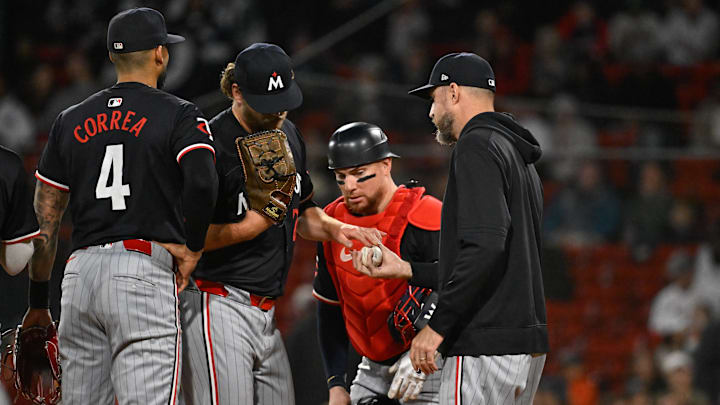The Five Biggest Factors Behind the Twins' Late-Season Collapse

Minnesota Twins catcher Ryan Jeffers strolled up to the plate Thursday night with the winning run on second base and no outs in the bottom of the 12th inning.
The Twins—in desperate need of a win over the 100-loss Miami Marlins to stay in the AL wild card race—had left the winning run on base in the ninth, 10th and 11th innings. So, manager Rocco Baldelli asked Jeffers to bunt the winning run over to third base.
Jeffers squared up. But instead of laying down a slow-rolling dribbler, his bunt attempt popped up and into the glove of first baseman Jonah Bride, who spun and fired to second base to catch Twins veteran Carlos Santana off second base for a double play.
this team is so aggravating, you cannot get doubled on a popup bunt pic.twitter.com/fkaTtM3pmI
— CJ Fogler account may or may not be notable (@cjzero) September 27, 2024
The Twins went on to lose that game 8–6 in 13 innings. That's pretty much how the entire month of September went in Minnesota.
Minnesota was 70–53 and had a 92.4% chance to make the postseason on Aug. 17 (per Fangraphs). They went 12–27 over the final six weeks of the season, allowing the up-and-coming Kansas City Royals and Detroit Tigers to leapfrog them in the AL Central and bounce them out of playoff contention.
As the team heads into the offseason with a bad taste in its mouth, here are five reasons to explain the Twins' recent meltdown.
Ownership significantly slashes payroll
The Twins' collapse all stems from a decision made by their ownership group last fall.
In 2023, Minnesota snapped a historic 18-game playoff losing streak that dated back to 2004 by defeating the Toronto Blue Jays in Game 1 of the wild-card series. They won Game 2, too, and advanced to the ALDS. It felt like the beginning of new era in the Twin Cities, a new brand led by Byron Buxton, Carlos Correa, Royce Lewis and Pablo López where October baseball became an annual tradition and expectation.
But just a few weeks after the final out was recorded in the Houston Astros' 3–2 win in Game 4 of the ALDS to send Minnesota packing, Twins president of baseball operations Derek Falvey told reporters that the franchise's ownership, led by the Pohlad family, planned to significantly cut payroll in 2024.
Minnesota's payroll went from $156 million in 2023, which ranked 16th out of 30 teams, to $130 million in '24, the 19th-highest payroll in baseball. That $26 million could've gone to another elite starting pitcher behind López (Blake Snell, for example, signed for $31 million per year), another right-handed bat (Manuel Margot went an MLB-record 0-for-30 as a pinch-hitter in 2024) or another reliable option in the bullpen (4.58 ERA in September).
From John Fisher moving the A's out of Oakland to the Pittsburgh Pirates designating Rowdy Tellez for assignment when he was four plate appearances away from a $200,000 bonus, the baseball world has witnessed some heinous acts of greed by ownership groups in recent weeks.
The Pohlads' decision to trim the payroll is another notch on that ever-growing list across baseball by prioritizing their bottom line over what could have been the start of something special in Minneapolis.
Slumping (and injured) stars
"I don't do that slump thing," Twins infielder Royce Lewis told reporters in June.
It was a bold quote, but there wasn't any reason to believe it wasn't true at the time. Lewis, who missed two months due to a quad injury suffered in the season opener, was batting .380 with eight homers and 12 RBIs in his first 14 games this season, a stretch that followed a heroic 2023 playoff performance. The former No. 1 pick of the 2017 draft looked like the real deal.
But reality set in for the rest of the year. Lewis tempted the baseball gods with that quote and ended up slumping for most of the year, batting .206 with a .634 OPS after June 19.
Additionally, star shortstop Carlos Correa missed most of July, all of August and half of September with plantar fasciitis in his right foot. When the slumping Twins needed him most, he wasn't available to play.
Despite Lewis's struggles and Correa's injuries, it is worth noting that Byron Buxton played more than 100 games for the first time since 2017 and had a solid year, batting .279 with an .859 OPS. It just wasn't enough.
Jhoan Duran's regression
In 2023, the Twins debuted one of the best entrances in baseball for closer Jhoan Durán. Ahead of the top of the ninth inning at Target Field, the lights would dim and each fan's cell phone would light up. That, paired with flames engulfing every jumbotron and screen at the ballpark, set quite the scene when Durán emerged out of Minnesota's bullpen with his 104 mph fastball.
That same entrance returned in 2024, but Durán wasn't quite the same. He missed the first month of the year with an oblique injury. And when he returned, Durán's average velocity was down—a 100.5 mph fastball in '24 compared to a 101.8 mph fastball in '23—and he allowed a career-worst 8.0 hits and 10.9 strikeouts per nine innings to go along with a ballooned 3.64 ERA (it was 2.45 in '23).
Durán's struggles certainly didn't help a bullpen that lost Brock Stewart and Justin Topa to injury and that watched Caleb Thielbar and Jorge Alcala struggle when asked to pitch in high-leverage situations. Trevor Richards, the only player Minnesota acquired at the trade deadline, was a disaster. He hit two batters, walked 11 and sprayed seven wild pitches in 13 innings before getting designated for assignment in August.
Needless to say, the bullpen wasn't deep enough. And its high-leverage arms, aside from Griffin Jax, didn't live up to expectations.
No help for Pablo
Instead of trading for another starting pitcher to bolster the rotation, the Twins stood pat at the deadline and opted to roll with Pablo López, Joe Ryan, Bailey Ober and a bunch of youngsters the rest of the year.
That quickly backfired. Ryan was ruled out for the season in August with a shoulder injury, leaving López and Ober as the only proven arms in the rotation. Simeon Woods Richardson was the most consistent starter out of the Twins' young quartet (Woods Richardson, David Festa, Zebby Matthews, Louie Varland), but he didn't come through in September, logging a 6.48 ERA in his final five starts.
The 2023 Twins had López and Sonny Gray as a fearsome 1-2 punch. They could have traded for another starter at the deadline to give López another veteran behind him in the rotation. There were plenty of options out there—Alex Cobb (Cleveland), Jack Flaherty (Dodgers), Paul Blackburn (Mets) and Yusei Kikuchi (Houston), among others, were dealt near the trade deadline and all made positive impacts on their new teams. However, the Twins' front office opted to roll the dice on the roster they constructed and believed they had enough to win the underestimated AL Central.
Ugly City Connect jerseys
Alright, these gaudy City Connect jerseys had nothing to do with the Twins' collapse. But they certainly didn't help.
More of the Latest Around MLB
feed
